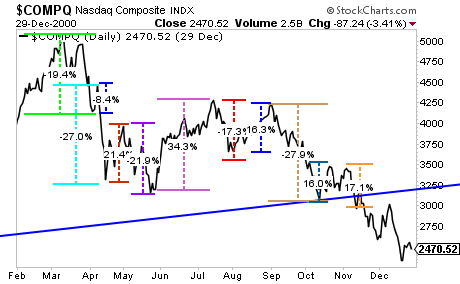"
The Fed continues to dangle hints of a “rate hike” in front of investors… but the reality is that as far as any significant raise in rates, its hands are tied.
True, the Fed may raise rates from 0.25% to 0.3% or possible even 0.5% sometime in the next 24 months… but these moves will be largely symbolic.
There are three reasons for this:
1) There are over $555 trillion in interest-rate based derivatives trades sitting on the big banks balance sheets globally.
2) The US Dollar carry trade is over $9 trillion in size.
3) Many Western welfare states would go bankrupt if rates normalized.
Regarding #1… the Fed cannot risk a significant rise in rates, as doing so would potentially burst the bond bubble. Bonds have been in a bull market for over 30 years now. Today, globally the bond market is over $100 trillion in size. And there are over $555 trillion in derivatives that trade based on these bonds.
This is why former Fed Chairman Ben Bernanke admitted that rates would not normalize anytime during his “lifetime”during a closed-door luncheon with several hedge funds last year. For rates to normalize (meaning rise to the historic average of 4%+) would trigger a derivatives implosion. Bernanke knows this. And current Fed Chair Janet Yellen knows it too.
Given that ALL of the Fed’s actions over the last seven years have been devoted to propping up the insolvent big banks (insolvent due to their massive derivatives portfolios), the Fed cannot and will not risk any interest rate surprises.
Regarding item #2 (the US Dollar carry trade), there are over $9 trillion in borrowed US Dollars sloshing around the financial system. These are effectively US Dollar (shorts) as when you borrow in one currency to fund a carry trade you are effectively shorting that currency.
US Dollar deposits yield 0.25%. The Yen yields 0.001%, while the Euro yields negative 0.2% and the Swiss Franc yields negative 0.75%.
In simple terms, the US Dollar is extremely attractive as a store of value relative to most major world currencies. This is why capital has been flowing into the US Dollar, pushing the US Dollar to a 10 year high.
The flip side of this is that every upward move the Dollar makes against other currencies puts more pressure on the $9 trillion worth of US Dollar carry trades. This is why the US Dollar’s rally has been so aggressive: because much of it was carry trades blowing up forcing traders to cover their US Dollar shorts.
On that note, the US Dollar is currently breaking out against most major world currencies.
This is already a big enough concern that the Fed has been mentioning it in FOMC communiqués. Any rate hike will only INCREASE the interest rate differential between the US Dollar and other major world currencies… which in turn would drive even more capital to the US Dollar… and put even more pressure on the $9 trillion US Dollar carry trade.
Finally, regarding #3 (the impact of interest rates on welfare states)… it is no secret that most western nations are bankrupt due to excessive social welfare expenses. Most nations rely heavily on the bond markets to fund their social spending patterns as tax revenues don’t come anywhere near enough to cover them.
In the US, a 1% increase in interest rates means over $100 billion more in interest rate payments. The US is already running a deficit (meaning that it spends more than it takes in via taxes) and has been for most of the last 20 years. As the above charts who, most Western developed nations are in similar situations.
If the Fed began to let rates normalize it would render numerous nations insolvent. Every asset under the sun trades based on its risk relative to Us Treasuries (the so called “risk free rate”). If US yields rise, so will yields around the world.
And the world cannot afford that.
In short, the world is awash with debt. The bond market has ballooned up to $100 trillion in size. And most nations are struggling to service their debt loads even with rates at historic lows.
At some point, the bond bubble will burst. And when it does, entire countries will go bust..."
Graham Summers
Phoenix Capital Research





















